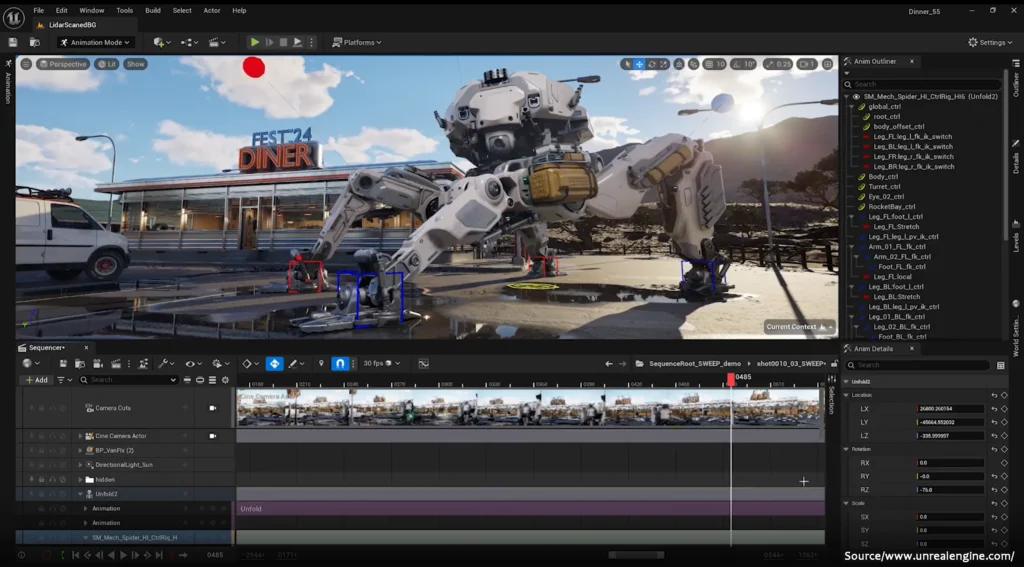Latest Features and Updates
Unreal Engine 5.5 has arrived, continuing its legacy as a cutting-edge tool for game development, virtual production, and immersive experiences. Packed with innovative features, this update refines existing tools while introducing groundbreaking capabilities to push the boundaries of creativity and efficiency. In this blog, we’ll dive into the key highlights of Unreal Engine 5.5 and how it empowers creators across industries.
Animation
Unreal Engine 5.5 introduces a suite of new features and improvements designed to streamline high-fidelity animation workflows directly within the editor. These advancements empower creators to animate in context, significantly reducing the need for back-and-forth exchanges with external DCC (Digital Content Creation) applications. Additionally, the update enhances the animation gameplay authoring toolset, offering expanded functionality and greater efficiency for developers.
Sequencer
The Unreal Engine 5.5 release introduces substantial improvements to Sequencer, the engine’s nonlinear animation editor, enhancing usability and productivity for creators. The updated interface is now more intuitive, offering advanced filtering options and streamlined property access. These refinements aim to minimize workflow fatigue and maximize efficiency during animation creation and editing.
One of the standout features is the addition of non-destructive animation layers, which bring a new level of control and flexibility typically associated with traditional DCC (Digital Content Creation) tools. These layers enable creators to:
- Easily manage their contents.
- Choose between additive or override modes for fine-tuned adjustments.
- Animate the weights of layers dynamically for more nuanced results.
These enhancements make Sequencer a more powerful tool for animators, allowing for more precise and versatile workflows while maintaining non-destructive editing capabilities. This update reinforces Unreal Engine’s commitment to providing industry-leading tools for animation and virtual production.

Finally, it’s now easier to set up different dynamic cinematic scenarios to be triggered interactively, such as conditional state changes based on player choices during interactive cinematics, or custom bindings for more nuanced control of objects within gameplay cinematics. You can also warp a sequence’s timing using a curve, and reposition the origin of a subsequence or shot
Animation deformers
Unreal Engine 5.5 introduces Animation Deformers, enabling creators to produce more realistic animation effects like contact deformation or enhanced cartoon-style squash-and-stretch. With this update, you can now easily create animatable deformers within Control Rig and apply them to characters in Sequencer with just a single click, adding more dynamic flexibility and realism to your animations. ..

The Animator Kit plugin includes a versatile collection of pre-made Control Rigs equipped with built-in deformers, such as Lattice, Camera Lattice, and Sculpt. Additionally, it offers several Utility Control Rigs that can be directly used in your animations or serve as templates for creating custom rig-driven deformers or helper rigs.
The Modular Control Rig
has entered Beta, featuring significant UI and UX enhancements, new modules for quadrupeds and vehicles, and compatibility with common bipedal skeleton types. Meanwhile, the Skeletal Editor is now Production-Ready, offering improved workflows for faster and easier weight painting and editing.
MetaHuman Animator
MetaHuman Animator a feature of the MetaHuman Plugin for Unreal Engine, receives a major upgrade in this release. Now available as an Experimental feature, it enables the creation of high-quality facial animations, including upper-face gesture inference, directly from audio performances. This fully local and offline solution supports multiple voices and languages, with options for batch processing and scripting alongside other MetaHuman Animator inputs.

Mutable character customization
The Mutable character customization system is now available for game developers looking to create content that dynamically adapts at runtime. This system enables the generation of dynamic skeletal meshes, materials, and textures for characters, animals, props, weapons, and more, all while optimizing memory usage, minimizing shader costs, and reducing draw calls.
Unlike traditional runtime modification tools, Mutable allows for extensive customization with numerous parameters and texture layers, complex mesh interactions, and texture effects that are typically not GPU-friendly.
You can explore the capabilities of Mutable in its dedicated sample project, which will be released in the coming days.

Choosers
In addition, Choosers move to Production-Ready. Offering a framework for selecting animations for playback based on game context without having to write complex logic, this robust game context asset selector can now be used to select nearly any type of asset; this can encompass multiple levels of complexity, from simple random selectors to database-driven logic involving thousands of animations.
You can try out these features in the https://www.fab.com/listings/880e319a-a59e-4ed2-b268-b32dac7fa016
Rendering
In the realm of rendering, we remain committed to fulfilling the performance and fidelity goals of Unreal Engine 5, while striving to lead the industry in real-time rendering innovation.
Lumen
Lumen now achieves 60 Hz performance on supported hardware platforms, thanks to numerous enhancements to the systems powering hardware ray tracing (HWRT). These advancements also improve the performance and functionality of the Path Tracer and light baking workflows.

Path Tracer
The DXR-accelerated, physically accurate progressive rendering mode, Path Tracer, is now Production-Ready. It delivers unmatched quality for generating final pixels in nonlinear applications or highly detailed ground-truth reference images. This release introduces various performance and fidelity enhancements, adds Linux support, and integrates compatibility with all other Production-Ready features, including sky atmosphere and volumetric clouds.

Substrate
Substrate, the material authoring framework first introduced as Experimental in Unreal Engine 5.2, has now progressed to Beta. It supports all features of legacy materials and is compatible with every platform to which Unreal Engine deploys. While optimization for real-time applications is still underway, Substrate is fully ready for linear material production. Look development artists can take advantage of its powerful and flexible framework for greater control over the appearance of their objects.
Movie Render Graph
Movie Render Graph (MRG), introduced as Experimental in Unreal Engine 5.4, also advances to Beta in this release. Enhanced investment in its graph-based configuration workflow has led to notable improvements, including the ability to use custom EXR metadata, refinements based on user feedback—such as support for Spawnables in Collections—and improved compatibility with the legacy preset configuration, including Object ID support.
Furthermore, MRG’s Render Layers feature now fully supports all asset types, including translucent objects, Niagara FX, Heterogeneous Volumes, Landscapes, and Sky Atmosphere, without requiring a Sky Sphere.

Finally, MRG provides access to an Experimental new spatio-temporal denoiser for Path Tracer, yielding high-quality results for linear sequences.
MegaLights
This release introduces an Experimental feature called MegaLights, often referred to as “the Nanite of lights.” MegaLights allows you to add hundreds of dynamic, shadow-casting lights to your scenes without limitations. For the first time, lighting artists can freely use textured area lights with soft shadows, Light Functions, media texture playback, and volumetric shadows on both consoles and PCs. This enables artists to focus on creative decisions rather than worrying about performance constraints.

Virtual Production
Unreal Engine continues to lead the virtual production revolution with its specialized in-camera visual effects (ICVFX) toolset, widely used in film, television, and commercial productions worldwide. With Unreal Engine 5.5, the ICVFX toolset has reached full production readiness, reflecting the cumulative advancements made over several releases. Additionally, this update includes enhancements to other features designed for virtual production and visualization.

SMPTE 2110
Unreal Engine now offers robust support for SMPTE 2110, featuring numerous stability improvements, automatic detection and repair of framelock loss, and the ability to use PTP as a timecode provider. It also includes OCIO support for 2110 media and enhancements to IP video signal flow, making it ready to meet the demands of real-world ICVFX projects transitioning to SMPTE 2110 deployments.
Camera Calibration
The Camera Calibration solver is now Production-Ready in Unreal Engine 5.5, delivering significantly improved accuracy in estimating lens and camera parameters. As part of these advancements, Overscan is now integrated into all cameras, supporting workflows like rendering with lens distortion and adding camera shake during post-production.
Virtual Scouting
The updated Virtual Scouting toolset, introduced in Unreal Engine 5.4, is now also Production-Ready. It offers a comprehensive out-of-the-box experience with OpenXR-compatible HMDs, including default support for Oculus and Valve Index. The toolset introduces a VR Content Browser, asset placement capabilities, and a customizable Transform Gizmo via Blueprint. Additional refinements include a color-correct Viewfinder, providing enhanced usability and new opportunities for customization through its extensive API.

Color Grading Panel
Previously part of the ICVFX Editor, the Color Grading Panel is now available for general use in the Unreal Editor. This artist-friendly interface allows for creative color manipulation in any Unreal Engine scene, offering an improved color grading experience for all artists—not just those working with nDisplay. The panel now supports post-process volumes, cine cameras, and color correction regions, further enhancing its versatility.
DMX
Unreal Engine’s DMX technology stack is now Production-Ready, with enhancements to the Control Console, Pixel Mapping, and Conflict Monitor. This toolset, which has applications in virtual production, broadcast, and live events, also adds GDTF compliance to the DMX Plugin, enabling integration with GDTF- and MVR-enabled control devices and software, along with several other improvements.
Fab Integration
Last month, we introduced Fab, our new unified content marketplace, and it’s now fully integrated into Unreal Engine 5.5. This integration allows you to easily drag and drop individual assets, such as Quixel Megascans, directly into your scene. You can also add asset packs from Fab directly to your Content Browser, streamlining your workflow and expanding your creative possibilities.


One Response